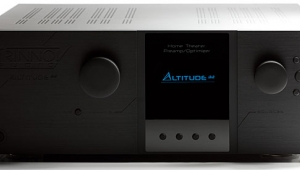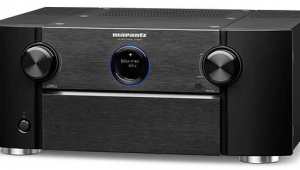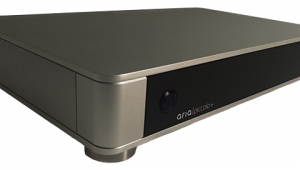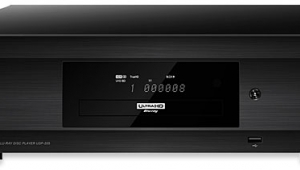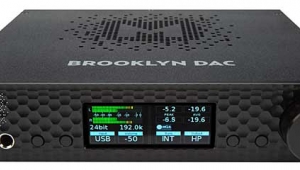| Columns Retired Columns & Blogs |
Music in the Round #10
Along with speakers and their placement, the greatest influence on the sound of a music system are the acoustics of the room itself. With two-channel stereo, some reflections and reverberations are necessary in order to maintain the perception that one is listening in a real space. So, while many experts recommend having a "dead" end behind and near the speakers that absorbs most sound, few suggest such treatment for the rest of the room. With too few sonic reflections, the stereo image would narrow; without the aid of "room gain" to enrich the bass, the sounds of instruments and voices would be thin. Listening in an anechoic chamber is interesting and informative, but far from pleasurable.
For a while, I labored under the misconception that multichannel setups were greatly immune from the problems of room acoustics because the sound is dominated by the acoustical cues of the reproduced ambience, whether real or synthesized. Of course, that's as wrong for surround sound as it is for stereo—the room's acoustical signature abides, and the new surround cues are merely superimposed on them. Still, it's much easier with multichannel to "listen through" the room into the transmitted reality, if only because there are more cues to better camouflage the room sound.
For years, I've tried to listen straight through the acoustical elephant in the room—the room itself. My room's dimensions of 16' by 16' by 8' high, however, made for very discrete, predictable, and significant nodes and nulls. A 35Hz mode was made inevitable by the room's length and width, while the ceiling height supported the first harmonic of that mode, at 70Hz. So when I tuned an ASC SubTrap to 70Hz, no wonder it did wonders. However, the SubTrap had no effect on the higher-frequency harmonics or the slap echo between the walls. A more comprehensive approach was needed to deal with the dimensional resonant modes, as well as with the abiding liveliness of the plasterboard-enclosed space.
RealTraps and the Real World
What turned me from acceptance to action was a visit my wife and I made to Bob Ludwig's Gateway Mastering Studios in Portland, Maine. We were astonished by the sound in the main mastering room—or, rather, the lack of sound. Sure, it was dead quiet, but our voices were remarkably pure and localizable in a way that seemed both refreshingly direct yet perfectly natural. Instead of having to use our brains to identify and extract these sounds from the acoustic morass of daily life, the lack of any noticeable ambient contribution from the mastering room relieved us of that arduous and constant effort. A breath of acoustical fresh air!
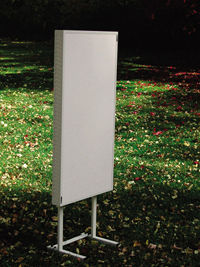 As Bob told us about his work and demonstrated some interesting contrasts between the CD and SACD releases of familiar recordings, I was struck by how much more was going on inside each mix in that particular room, In particular, we listened to a few excerpts from Benjamin Zander's multichannel SACD of Mahler's Symphony 5 (Telarc SACD-80569), which sounded better than it has in any other demo. I'd heard this recording at home and at a stupendous Halcro-Revel demo at the 2003 Consumer Electronics Show, but those sounds paled compared to what I heard at Gateway. Of course, all of Bob's equipment is topnotch; but by discarding the cloak of room acoustics, the system could communicate the sound of the music transparently. I want that.
As Bob told us about his work and demonstrated some interesting contrasts between the CD and SACD releases of familiar recordings, I was struck by how much more was going on inside each mix in that particular room, In particular, we listened to a few excerpts from Benjamin Zander's multichannel SACD of Mahler's Symphony 5 (Telarc SACD-80569), which sounded better than it has in any other demo. I'd heard this recording at home and at a stupendous Halcro-Revel demo at the 2003 Consumer Electronics Show, but those sounds paled compared to what I heard at Gateway. Of course, all of Bob's equipment is topnotch; but by discarding the cloak of room acoustics, the system could communicate the sound of the music transparently. I want that.
I did some research on acoustical treatment and found it generally obtrusive, visually and/or physically. The bottom line is that one cannot deal effectively with low frequencies without treatments of large size, and we're not yet ready to accommodate stacks of tubes and boxes in what is also our den and relaxation space. Still, I was committed to doing something.
RealTraps just happens to be located in our hometown in Connecticut. After some telephone discussions, we visited the home of RealTraps' Ethan Winer, where I experienced an acoustic nearly as neutral as that at Gateway. My wife, however, was not thrilled to see that it came at the price of dozens of RealTrap panels covering almost every room surface, including the ceiling.
Acting boldly, I arranged to borrow some RealTraps. Fortunately, my wife was out in the garden when Winer and Doug Ferrara drove up with a truckload of panels and set them up. They put three MondoTraps ($279.99; all prices are for single units) across the back of the room, two MiniTraps ($179.99) angled across the wall/floor junction between the front speakers, a 2' by 2' MiniTrap ($119.99) in each rear floor corner, and a pair of HF MiniTraps ($179.99) on stands ($60), one at the first reflection point on each side of the room. Although they urged me to take even more panels (their philosophy seems to be that more is better), I demurred. I had hoped that these flat panels (2.25–4" thick) of fiberglass, with cosmetically neutral covers and frames, might not upset the décor or my wife. However, as Ethan Winer is quick to instruct, RealTraps are more effective at low frequencies when placed across the junction of room boundaries, and most effective in corners. But even these few Traps were more than my wife could endure; only assurances of their eventual removal placated her.
However, everyone who has heard the room both before and after agrees that the RealTraps have made a major improvement, usually along the same lines as my impressions at Gateway Mastering. Every sound in the room, real or reproduced, is more defined in character and location, an effect I can demonstrate simply by walking into the room while speaking. Instruments and voices from well-recorded discs sound more natural and varied, as they do in concert halls or clubs, without the homogenizing effect of a constant room acoustic. Also, while I can now better define the location of reproduced sounds in their transmitted ambience, it is much more difficult to localize the speakers in the room. Even former colleague Jonathan Scull, who was making an otherwise social visit, remarked about how the treatment made my Paradigm Reference Studio/60s seem to disappear.
The human brain has a difficult time localizing a side sound from front and rear speakers, and poor acoustics make the task harder. In practice, some otherwise satisfying recordings, such as Willy Nelson's Night and Day DVD-Audio disc (Surrounded By Entertainment SBE-1001-9), can distract the listener with instruments seemingly isolated in the rear channels. No longer. Sure, the instruments still wrapped around me, but now as a continuous ensemble from front to back. Finally, the speakers simply sounded smoother and more integrated than before. This was best demonstrated with the recordings of the Berlioz Requiem. It is all too common, in massive passages such as the Tuba Mirum, for the chorus and orchestra to be engulfed by the timpani or for the brass to sound forward and disconnected from the ensemble. But whether with Robert Spano/Atlanta Symphony SACD (Telarc SACD-60627) or the Maurice Abravanel/Utah Symphony (DVD-A, Silverline 288238-9), everything hung together. Quiet portions were delicately detailed, and the big stuff wasn't just loud, but huge.
How was this accomplished? Using room analysis and measurement, I found that the 35Hz fundamental gave a –6dB null in the listening area, but that was alleviated when the subwoofer was moved close to the rear corner. The fundamental resonance of the room height and the first harmonic of the length and width modes coincided for a 70Hz peak on the order of 8dB, but this was not the biggest problem. The next harmonic (for all three dimensions) was at +18dB at 140Hz. That was the elephant in the room, and it was essentially erased by the RealTraps.
The other major improvements were in imaging, detail, and soundstage width, due to the absorption of the first lateral reflections wrought by the stand-mounted HF MiniTraps. I know this for certain because I stowed these units in the shower on days when the housekeeper cleaned the room; the A/B comparison was decisive.
- Log in or register to post comments


